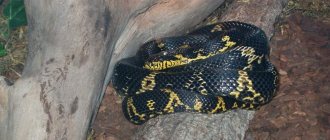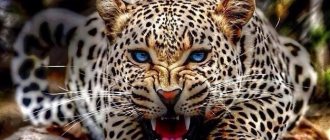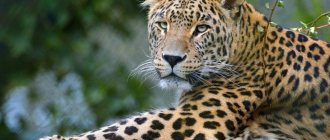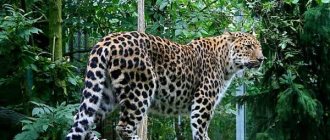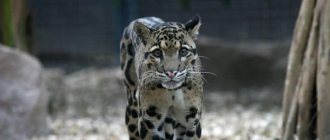The Far Eastern, Siberian or Amur leopard is an amazing predator, which today is on the verge of complete extinction from the face of planet Earth. Only man can stop the extinction of this beautiful animal. At the end of 2022, in a specially protected natural area in Russia in the Land of the Leopard National Park and the Kedrovaya Pad Nature Reserve, there were 84 adult Siberian leopards and 19 small ones, 7 of them teenagers. The exact number of predators living on the border with China and Korea and outside protected areas is not known, but it is not at all large. Today there are 170 individuals living in captivity, which began to be bred from 9 in 1961.
History of the discovery of the species
The first description of a zoological specimen found in Korea - a dark leopard skin - was made by the scientist Hermann Schlegel in 1857. He gave the predator a scientific name: Felis orientalis. The predator received its current Latin name only in 1961, when in one of her works Ingrid Weigel described it as Panthera pardus orientalis.
Phylogenetic analysis of leopard samples from Primorsky Krai and North Korea showed that they cannot be distinguished. It is considered likely that carnivore populations became fragmented less than a century ago.
Not far from the Amur leopard lives another species of Panthera pardus (Leopard) - japonensis or North China leopard, described in 1862 by zoologist John Edward Gray. The specimen was the dark skin of a spotted cat, which is now kept in the British Museum. The species lives in northern China, except the northeast. The erroneous name japonensis, which means Japanese, was given to the leopard because its skin was sold in this country.
The North China leopard, which lives near the Far East
Social structure
Leopards prefer solitude, but can live in pairs and families.
On the male's property there are several areas of females, which reach an area of 60-100 sq. km. In this territory she lives with her offspring. Leopards regularly walk around their properties and place their characteristic marks on trees at their borders. You can often see so-called scrapes on the ground.
Characteristics of the Amur leopard
The Amur leopard differs from other species of this animal by its thick fur of a pale cream color, this shade is especially characteristic in winter.
The rosettes on the sides measure 5x5cm and are widely spaced, spaced up to 2.5cm apart, with thick unbroken rings and darkened centers.
The predator's fur is quite soft with long and thick hair. The length of hair on the back is 20-25 mm in summer and up to 70 mm in winter. The winter coat ranges from a fairly light yellow to a dense yellowish-red with a golden tint or a rusty reddish yellow. In summer, the fur becomes brighter with a more pronounced color pattern.
This is a fairly small predator, males are larger than females. Males range in size from 107-136 cm with a long tail of 82-90 cm, height at withers 64-78 cm and weight 32.2-48 kg. Females weigh from 25 to 42.5 kg.
Finding loot
The predator goes hunting in the evening, shortly before sunset, finishing its search for food in the first half of the night. Comes to the watering hole at dusk.
The leopard uses 2 attack tactics:
- to ambush;
- sneaking and sudden jump 5-7 m.
It eats the hunted carcass for about a week, and tries to drag the remains into a shelter. In winter, when daylight is short, the animal hunts during the day. The predator can go without food for up to 2 weeks.
Mr. Cat tells: habitat of the Far Eastern leopard
Today, Amur leopards live only in Primorye and on the border of three countries - Russia, China and North Korea. They cross these three states via the Tyumen River, despite the high and long wire fence marking the border. Previously, i.e. Until the end of the 19th century, the Leopard's range extended across the south of the Ussuri region and the Amur region in Russia, the northeast of China (Manchuria), the north of China down to the south (Beijing), and the Korean Peninsula. Additionally, fossils of the Amur leopard from the Pleistocene have been excavated in Japan, but the species has not been identified by scientists with certainty.
A sharp decline in the Leopard's habitat began in the 20th century. Due to the development of new lands by humans, predators were forced to split into different groups, which were isolated from each other. Initially there were three of them, but by the 80s of the 20th century it turned out that of the three only one remained, namely in the southwestern part of Primorsky Krai and in the provinces of Heilongjiang and Jilin in China (the border of China and Russia).
As for the Primorsky Territory, the Leopard lives there in very rugged terrain of mountain-forest areas with altitudes of 300-600 meters above sea level, where there are roe deer, badger, sika deer, Manchurian hare and raccoon dog. This is mainly the upper and middle reaches of rivers near the border of Russia and China, in particular, on the Borisov Plateau (prefers forests with cedars, black fir, broad-leaved trees, but visits oaks less often). In the steppes and open forests, the Leopard is almost never seen, except when it enters deer parks. It is difficult for the Amur leopard to spread, not least because of the depth of the snow cover; it cannot move through snow that is too deep. In the winter months, it selects the warmest zones with an average long-term snow depth of no more than 10-15 cm.
As for the Chinese provinces of Heilongjiang and Jilin, there are about 20-30 individuals left there. The first hidden camera image of an Amur leopard in northeast China was captured in 2010 at the Hunchun National Nature Reserve, located in the Changbai Mountains. In this zone, the Leopard's habitat consists of broad-leaved coniferous and Korean pine forests at altitudes of 600-1200 m above sea level, where the average annual temperature is about +1.5 °C. Leopards were photographed in this area on numerous occasions using camera traps set between January 2013 and July 2014, covering almost five thousand square kilometers.
In other areas of China, the range of the Far Eastern leopard is fragmented with small populations living mainly in isolated nature reserves. In Shanxi province, predators were recorded in 16 protected areas during camera surveys from 2007 to 2014. Here, leopards have been recorded in six reserves, including Foping National Park.
The search for the predator in the north of North Korea was unsuccessful, although the presence of a small number of them there is still not excluded. In South Korea, the last records of the Amur leopard date back to 1969, when an adult male was caught on the slopes of Mount Odow, South Gyeongsang Province.
Nutrition
Leopards are not too picky when it comes to food, because the population of potential prey is rapidly decreasing, so the animal does not disdain small prey. The basis of the predator’s diet consists of the following fauna:
- Roe deer.
- Noble deer.
- Seals.
- Wild boar or piglets.
- Red deer calves.
In the absence of the main hunting objects, the animal easily switches to badgers, hares, raccoon dogs, pheasants and hazel grouse.
Scientists have also recorded cases of leopard attacks on small moose calves, bear cubs or wounded bears. They do not disdain carrion. After all, an adult’s hunger strike can last no more than 14 days. Plants are also included in the animal's diet. This information was obtained by examining feces in which traces of flora representatives were found. Typically, an animal eats grass to cleanse the gastrointestinal tract, and not as a necessary addition to the diet.
Features of behavior
Amur leopards are solitary predators, with the exception of females with offspring. Recordings from camera traps show that they are more active during the day than at night and at dusk, in both summer and winter. This behavior pattern coincides with the lifestyle of potential prey species such as Siberian roe deer, sika deer and wild boar.
They are extremely conservative in their choice of territory. The leopard's hunting area is usually located in a river basin, which often extends to the natural topographic boundaries of the area. The territories of two individuals sometimes overlap, but only slightly. Depending on the sex, age and size of the group, the size of the land of one Amur leopard varies from five to thirty thousand hectares.
Animals use the same hunting trails, migration routes and even resting places for many years.
Source: yandex.ru
Lifestyle
This representative of the feline is a predator leading a solitary lifestyle. One adult individual has hunting grounds of 239–509 km2. Usually such massive possessions belong to males, while females need much smaller possessions - up to 128 km2. A wild animal can coexist with representatives of the opposite sex, rigidly protecting the center of its territory from brothers of the same sex.
This representative of the feline defends its possessions only from seizure attempts. So, a male can attack another male if he tried to mark his territory. Young representatives of the same sex are allowed to cross the domain of the dominant male and even hunt them.
Scientists note the presence of hunting trails used by several leopards at once. It is crepuscular or nocturnal, leaving its shelter approximately 2 hours before sunset and returning to it by the middle of the night. But several cases of leopard hunting during the day have been recorded. This is the exception rather than the rule. Animals usually form dens on a permanent basis. They do not leave their shelters throughout their lives or several years.
Diet
Leopards live in areas where wild animals live and follow herds of ungulates. In the Ussuri region, the main prey of Far Eastern leopards are roe deer (Capreolus pygargus), Manchurian sika deer (Cervus nippon mantchuricus), wapiti or Manchurian wapiti (Cervus canadensis xanthopygus), Siberian musk deer (Moschus moschiferus), Amur elk (Alces alces cameloide s) and wild Ussuri wild boar (Sus scrofa ussuricus). They also catch hare (Lepus), Eurasian badger (Meles meles), birds and mice.
Capreolus pygargus or roe deer
In the Kedrovaya Pad Nature Reserve in Primorsky Krai, roe deer are their main prey all year round, but they also prey on young Asian black bears if the predators are at least two years old.
When ungulate densities are low, Amur leopards have large hunting territories, up to one hundred square kilometers.
During a radar study of Far Eastern leopards in the early 1990s, a territorial fight between two males on a reindeer farm was documented, suggesting that the predators prefer such hunting grounds.
Source: yandex.ru
Female Amur leopards with cubs are often found in close proximity to reindeer farms. The large number of domesticated ungulates provides a reliable source of food in times of need.
In 2011, an adult female Amur leopard was tagged and radio-collared near the Leopard National Park in the Khasansky district of Primorsky Krai. During three years of tracking, she lived over an area of more than 160 km², with a central zone of about 23 km². During estrus, it moved in a core with an area of 50 km². After giving birth at the end of June, she reduced her movements to an area of 3 km² in a month, during which she carried her cubs three times. Since the fall, she has gradually increased the range of her home. When the offspring were over a year old, the family moved to an initial range of 160 km².
Amur leopards share habitat with Siberian tigers, but in the Changbai Mountains (on the border of China's Jilin province and the DPRK) they are more often found at higher altitudes and away from populated areas and roads than striped predators.
Siberian tiger
Enemies
wild animals are tolerant of competing predators. However, encounters with some animals may result in a fight. Among the potentially dangerous animals it is worth highlighting:
- Domestic dogs.
- Wolves.
- Tigers.
- The Bears.
It is domestic dogs that pose the greatest danger to this predator. After all, the spotted animal most often becomes a victim of their attacks. Meetings with a hungry pack of wolves can also end sadly. Fights with tigers and bears are extremely rare.
Puberty and reproduction
Amur leopards become sexually mature at the age of two to three years. Capable of reproducing offspring up to 10-15 years. Estrus in a female lasts 12-18 days, and in exceptional cases up to 25 days. Pregnancy requires 90-105 days, but usually 92 to 95.
A newborn cub weighs 500-700 grams and opens its eyes on the 7-10th day after birth, and begins to crawl on the 12-15th day. By the second month of life, the babies emerge from their den and begin to taste meat. Mothers wean their cubs when they are three months old, and after that they learn to hunt. However, the female continues lactation for five or six months.
Young Far Eastern leopards achieve independence at approximately two to three years of age. They stay with their mother until they are between 18 months and two years old. Juveniles sometimes remain with the parent until she comes into estrus again.
Until the 1970s, cubs could be seen in the Kedrovaya Pad Nature Reserve and northeastern China, most often from late March to May. Litters contained two to three cubs. In captivity, some animals lived for 21 years.
During the 1997 census of Amur leopards, four females found with their young had only one cub each. The results of radiotelemetry studies confirmed that the youth remains with their mother for two years. In the Kedrovaya Pad Nature Reserve, young leopards from two different litters were observed simultaneously with their mothers.
Popular message topics
- Hornbeam tree
Hornbeam is a deciduous tree from the birch family. The tree's height can reach 30-40 meters, its lifespan can be up to 250 years, and its diameter can be about 2 meters. There are about 40 varieties of this tree, - Temples of Ancient Egypt
Religion was an important component of Egyptian society, and temples were an integral part of everyday life. People gathered to worship in the temple, made sacrifices to the gods and participated in various rituals. - Flying squirrel
The flying squirrel is a record holder for long jumps, living throughout Eurasia. Appearance of the animal. She is very similar to an ordinary squirrel, has a small muzzle, large black eyes that help her see well in the dark),
Threats to the survival of the Amur leopard
The problems that threaten the Amur leopard are poaching, the extermination of species of its potential prey, the disappearance of forests due to their deforestation and active human development of the predator’s habitats. Human construction of new roads and forest fires also pose a great threat to the disappearance of the natural habitats of the Amur leopard.
Since the Far Eastern leopard reproduces very little, its gene pool suffers greatly, breeding lines often intersect, which leads to constant inbreeding and weakening of the offspring and even the birth of inferior individuals.
It has been noted that modern populations of the predator in Primorye have even begun to suffer from a disease such as canine distemper, which also indicates the degeneration of the species and inbreeding depression.
Due to the very low densities of the species that are potential prey for large wild cats, competition between predators is high. Thus, tigers pose a great threat to the Amur leopard for this reason. It is slightly lower in winter and especially high in summer.
Source: yandex.ru
But the main evil that contributes to the extinction of the Far Eastern leopard is their targeted extermination by humans; government agencies have still not been able to cope with poaching. It is thriving due to the very high interest in the bright skin of the animal from Chinese smugglers, while in the early 2000s their cost reached only $750-$1,000.
Leopards are most often killed by residents of small Russian villages around the predators' habitats. Most people hunt completely illegally, they do not even have gun licenses, and they are not members of local hunting unions.
As for fires, they most often occur in Primorye as a result of local farmers setting fire to fields. These are not targeted malicious actions - they are carried out to improve pastures and increase the fertility of cattle, remove pests and weeds, and improve the growing conditions for ferns, which are a local delicacy and are highly prized.
Satellite surveys have found that up to one-fifth of coastal forests burn each year and nearly half disappear completely every six years. In fact, the share of pastures in Primorye is now comparable to the forest zone. Due to constantly recurring fires, instead of dense taiga, Primorye is gradually turning into savannas and semi-savannas with sparse bushes and single oaks, in which there is a low density of ungulate herds and there are no conditions for the survival of the Amur leopard.
Previously, there were many large reindeer farms in Primorye, the number of which was greatly reduced by the 2000s. At the same time, active economic activity began in the southwestern part of the Primorsky Territory, which also ultimately leads to degradation of the Amur leopard’s habitat. But today, fortunately, the construction of an oil pipeline from central Siberia through Primorye to the coast of the Sea of Japan has been postponed, and the development of a coal mine has been suspended. This is a victory for local environmentalists. However, since the Primorsky Territory has a very advantageous strategic location with large settlements and close borders with the Sea of Japan, China and Korea, it still remains very attractive in terms of the development of industry and tourism, logistics networks and timber rafting, infrastructure , which reduces the Amur leopard's chances of survival.
Unfortunately, this unique wild cat can disappear from the face of the planet even without human activity, simply as a result of depressive inbreeding. Scientists believe that this problem arose a long time ago and affected more than one generation of predators. As evidenced by the increasing number of reproductive and congenital anomalies, the decrease in the survival rate of juveniles in the first year of life has almost halved over twenty years.
In addition, there is a high probability of mortality in all age categories of the Primorsky leopard due to diseases and direct human exposure. Repeated genetic analyzes indicate that the Amur leopard population has completely lost its genetic diversity in a short time.
Today this unique wild cat is listed in Appendix I of CITES. But scientists say greater levels of protection are needed against the illegal trade in predator skins and body parts.
At the beginning of this century, world scientists and ecologists from many countries gathered in Vladivostok to develop an action plan to preserve the population of a unique predator on Earth. As a result, a protected zone was created in China (Jilin Province, Hunchun Nature Reserve), where today scientists from two countries - China and Russia - are collaborating.
The organization ALTA, the Alliance of Amur Leopards and Tigers, has been created by Russian and foreign ecologists, which is designed to protect the predators of the Far East in Russia and China. The main principle of this organization is the coordination of the actions of scientists and close cooperation with all local organizations. For the same purposes, the Phoenix Foundation and the Wildlife Conservation Society were created, which actively cooperate with ALTA.
Today, two groups of Amur leopards have been stabilized, one in Russian Primorye (about 100 individuals, of which 35 are females) and the second in China (60 predators, of which 20 are females).
ALTA projects for the conservation of Amur leopards are as follows:
- Four teams have been created to combat poaching, including 15 experienced researchers and hunters.
- A special task force has been formed, which includes representatives of the local police and anti-poaching teams, led by the Khasansky prosecutor.
- Constant monitoring of the number of predator individuals in protected areas is carried out, video traps and snow track counting are widely used.
- The impact of forest fires on the number of Amur leopards is analyzed, and the effectiveness of fire extinguishing measures is tested.
- Information is collected on the quality of the predator's habitat.
- All economic development plans are analyzed to take into account the needs of unique predators.
- The food supply is being grown.
- A special training program has been developed for schoolchildren and students living in Primorye.
- Special campaigns are constantly carried out in the media, which are designed to convey to residents the truth about the Amur leopard and tigers.
- Material and technical support is provided to the Hunchun Nature Reserve.
Reasons for the decline in numbers
In addition to extremely slow reproduction and population replenishment, the reason for the disappearance of the Far Eastern leopard was barbaric human activity.
Forests and territories suitable for hunting grounds for predators. They are rapidly declining under the onslaught of civilization, plus forest fires “help” by destroying vegetation and forcing herbivores to migrate.
This also includes highways and railways laid through age-old forests, plowing of land for fields, and uncontrolled cutting down of trees for logging.
Poachers who poison the animals with packs of dogs cause enormous harm to the small population of Amur leopards. Hunters strive to obtain the valuable skin of a beautiful animal, and Chinese healers pay more money for parts of the carcass used in the manufacture of potions.
Sometimes Far Eastern leopards become victims of deer park owners. Predators trying to get food for themselves are shot right at the scene of the “crime.” Very rarely, careless leopards are hit by cars passing along the highways.
Reintroduction of the Amur leopard into the wild
Since 1996, ALTA members have been discussing the idea of reintroducing Amur leopards to the south of Sikhote-Alin. During a workshop in 2001, the basic principles and plan for the development of a second leopard population in the Russian Far East were prepared. For the event to be successful, one fundamental question must be answered: why the unique predators disappeared from the southern Sikhote-Alin in the mid-20th century.
It was recommended to assess the causes of local extinction, enlist the support of the local population, increase harvest in areas proposed for reintroduction, ensure that conditions are conducive to the establishment of animals in the selected area, and ensure the survival of existing groups. There are two sources of Amur leopards for reintroduction: those born and bred in zoos, and those raised in a special center that have undergone a rehabilitation program for life in the wild.
In March 2009, the Russian Minister of Natural Resources, during a meeting with Vladimir Putin, assured that the ministry plans to introduce new “imported” leopards into the area and create a suitable and safe habitat for them. The government has already allocated all the necessary funds for the project.
Contiguous areas of potential Far Eastern leopard habitat as potential reintroduction sites have been identified in the southern Sikhote-Alin. The three coastal potential habitats could support approximately 72 adult raptors.
Meaning
Predators are forest orderlies. After all, the animal not only hunts, but also helps eliminate carrion from the landscape, which helps reduce the spread of various diseases and dangerous infections among forest inhabitants.
Status of this animal: on the verge of extinction. Therefore, people are doing everything possible to preserve its population. After all, each representative of the fauna plays its role. Thus, the wild cat regulates the population of herbivores, which contributes to the development of forests. Indeed, in the absence of predators, roe deer and deer would easily destroy all plantings, moving to gardens and fields of national importance. Which would lead to food shortages.
Interesting Facts
The name "Amur Leopard" was coined by Pocock in 1930 while he was comparing leopard specimens in the collection of the Natural History Museum in London. In particular, he called the skin of a leopard from the Amur Bay “Amur”. Since at least 1985, this name has been used for the entire spotted raptor population in Eastern Siberia and in captivity in zoos around the world.
The documentary film "The Last Leopard" talks about the plight of Amur predators in Russia. The television series “Wild Russia” showed viewers the true life of leopards in Primorye. The Leopardess and her cub were featured in the episodes "Planet Earth - Seasonal Forests" and "Pole to Pole". The female is called "Sneaky". The teenager died at about 18 months of age because he was the result of inbreeding - the baby's father was also his mother's parent.


